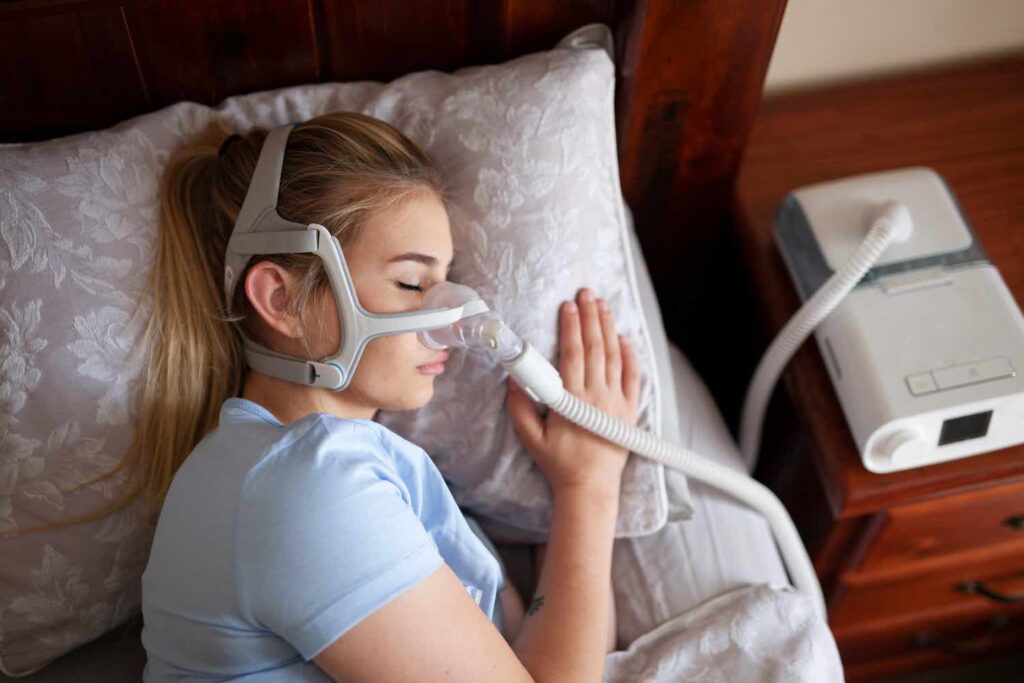When you first open the box for your brand-new CPAP machine, you have a lot of questions, such as how long will it last? What is the typical lifespan of a CPAP machine? And how often should you change the various components, such as the mask, cushions, and tubing?
The lifespan of a CPAP machine varies depending on the exact piece of equipment. CPAP devices are typically used for three to five years. CPAP masks, on the other hand, need to be replaced multiple times a year. Why? CPAP masks have several distinct pieces that are heavily used and hence wear out faster than other parts. The cushions of a mask, for example, may begin to wear out before the strap or hose. The length of time your CPAP mask lasts is determined by skin oils and regular washing, which, while highly recommended, can wear down your mask over time.
A mask’s headpiece, cushion, and cushions can stretch out; the tubing can rip or fracture; and the air filters can wear out. If any of these things occur without replacement, your cpap mach may be ineffective in sleep apnea therapy. That is why it is critical to replace your CPAP equipment on a regular basis. CPAP users who change their supplies on a regular basis report sleeping longer hours per night and using their treatment on more nights of the week.
Related: Sleep Apnea; Towards a Permanent Cure
Signs That Your CPAP Machine Needs to be Replaced
1. Your CPAP Machine is Making a Loud Noise: When inhaling first, rule out any air leaks in your CPAP mask or tubing breaks. These parts should be replaced every three months and are generally covered by insurance. If you’ve changed them and your machine is still producing strange noises, it might be an indication that the motor is deteriorating and you’re not getting enough air pressure for your therapy.

2. Your humidifier not requiring water as necessary: Or perhaps you’ve noticed that your water level isn’t dropping. In any case, it’s a dead giveaway that something is awry. If your humidifier isn’t built in, remove it and test your machine without it. It is possible that changing the humidifier will be less expensive than replacing the complete machine. Whether you use your insurance or not, you’ll need a valid prescription to purchase a new humidifier. If you need assistance locating or updating your original prescription, an Air Liquide Healthcare may help you get the best for your need with free consultation with us.
3. You’re Still Snoring Despite Using CPAP: Snoring is quite prevalent with sleep apnea, but you should not snore when using your CPAP. If you’ve resumed snoring, it suggests your pressure isn’t high enough to keep your airway from closing. But before you blame your system, here are some additional things you should try first:
- Examine your CPAP mask to ensure that the seal is tight, the cushion is free of cracks, and the headpiece is not strained.
- Attempt to sleep on your side. Sleeping on your back might contribute to airway obstruction.
- Experiment with a full-face mask. Your air pressure may be leaving while you breathe if you sleep with your mouth open. If you prefer nasal pillows or a nasal mask, consider wearing a chin strap in conjunction with your mask to keep your mouth closed.
If you’ve done everything and you’re still snoring, your machine may no longer be able to generate the necessary pressure. However, snoring when using a CPAP may also be caused by lifestyle changes or the need to alter your air pressure, so you should always see your doctor or healthcare provider about this.
4. You’re Still Tired of Using CPAP: If you’ve been waking up refreshed but suddenly find yourself experiencing severe daytime drowsiness, it’s possible that your CPAP machine isn’t providing appropriate sleep treatment.
As with snoring, you should try to rule out any other causes of a decrease in air pressure. If you’re still needing a nap, it may be time to replace your worn-out CPAP machine. It is also critical that you consult your doctor if any of your obstructive sleep apnea symptoms reappear. They may advise you to change your pressure settings or address other lifestyle issues.

Changing your CPAP machine, mask, and other accessories
Isn’t it the responsibility of your doctor or sleep therapist to ensure that your equipment is frequently replaced? Aren’t they the authorities on the lifespan of CPAP machines? Shouldn’t they keep track of the age of the goods you’re using-the CPAP machine, the mask, the hose that connects the two, and all other associated accessories?
The answer is yes, but you should be informed of how long your CPAP machine and associated equipment are predicted to endure. You may need to notify your doctor or sleep therapist that your equipment needs to be replaced.
Air Liquide Healthcare offers an online CPAP supply replacement guide with timelines for receiving new supplies. For example, your CPAP mask should be replaced every three months, while your cushions and filters should be replaced every two months. The headgear on your CPAP mask should be replaced every six months, and the tubing connecting your mask to the machine should be updated every three months.
The good news is that most health insurance companies will replace supplies in accordance with these replacement dates. Check with your insurance provider to see whether you are qualified for regular CPAP equipment replacement. Alternatively, check with your doctor to see whether he or she is aware of the appropriate replenishment periods. As a result, your sleep apnea therapy will be as constant and successful as possible.
Making it simple to obtain new CPAP supplies ResMed offers a programme to assist you in replacing your CPAP supplies on a regular basis in accordance with your insurance’s replacement eligibility. Find out more about ResMed ReSupply or contact your equipment provider.